Denali Riblet Climb 1996
Background
For several years I had wanted to climb Denali (aka Mount McKinley) in Alaska. I had participated in early planning of two expeditions with friends, but had to withdraw from both. Finally, in the Fall of 1995 I decided the time and circumstances were right to join a guided trip. In that way I could minimize the logistical planning and preparations and instead focus on obtaining equipment and getting training. I could also attempt an alternate route to the standard West Buttress route and learn from an experienced Alaskan mountain guide.
In my research I determined that Fantasy Ridge Alpinism (Telleride, Colorado) was a superior guiding service with a solid record of guiding on Denali and offering a West Ridge expedition. As it turned out, the weather conditions forced us to modify our route plans. The guides, Lyle and Jim, were excellent and I had a successful and very rewarding experience. Fantasy Ridge Alpinism has since transferred its Denali guiding permit to Alpine Ascents International in order to focus its services elsewhere.
Diary
1 June 1996 Fly from Portland to Anchorage, arriving about midnight.
2 June Get room at Anchorage Holiday Inn and move my gear in. Walk around downtown and rest in the room.
3 June Meet other clients (including Al, Bob, and Julian) and ride with van driver Bob Sloezen (Everest summitter) to Talkeetna and the Swiss Alaskan Inn. Meet lead guide Lyle Dean and assistant guide Jim Nigro. Lyle and Jim scrutinize our gear and instruct us to replace or add to our gear.
4 June Practice procedures and shop
for our last gear.
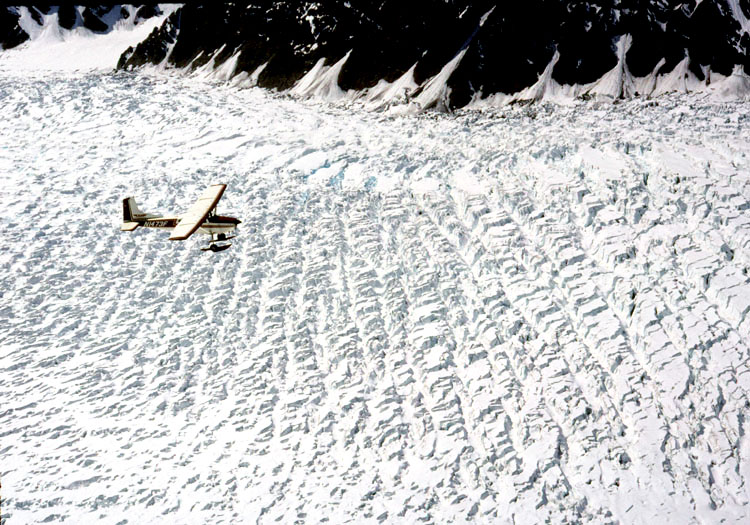
Crevasses on the Kahiltna Glacier
5 June Fly in and land at Kahiltna Base Camp (7700 ft). Snow is soft and the sun hot, so we rest, eat a big meal, then move camp in the evening (10-12pm) to a point facing the East Fork of the Kahiltna (7300 ft).
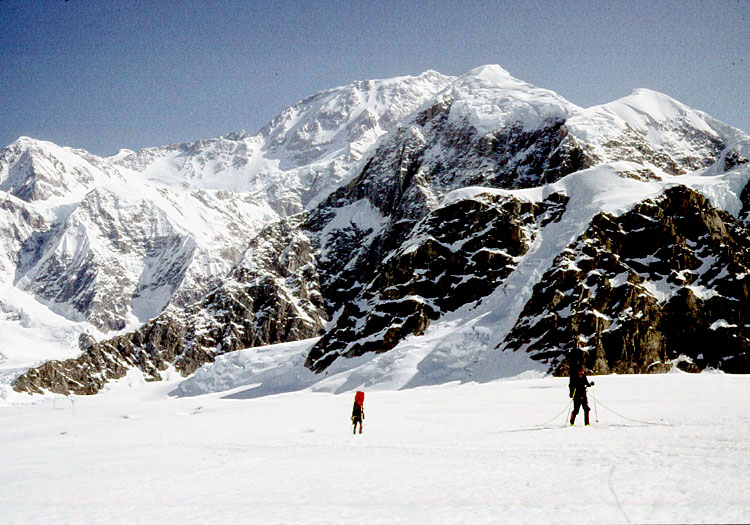
Denali from the Kahiltna Glacier
6 June Rest at camp until about 9pm, eating as much of the heavy food as we can and watching climbers descend the glacier. Move camp up near the base of Ski Hill (8000 ft) facing into the Northeast Fork of the Kahiltna.
7 June We are tentbound due to heavy snowfall.
8 June Tentbound, again, due to heavy snowfall.
9 June Lyle decides we have to move up, regardless of the weather. Start up the NE Fork, but more poor weather soon arrives and we instead turn up Ski Hill on the Kahiltna to cache our gear at 9700 feet. One of the clients decides to leave.
10 June Jim and Julian escourt the client to the landing strip while the rest of us move camp to our cache (9700 ft). Jim and Julian rejoin us at camp and report large avalanches in the NE Fork.
11 June Carry supplies to just below Motorcycle Hill (11000 ft) and cache it. We bury it deep enough that the ravens cannot raid our food.
12 June Move camp to just below Motorcycle Hill (11000 ft).
13 June Carry supplies to just beyond
Windy Corner (13400 ft) and cache it. Return to camp. It is a tiring day.
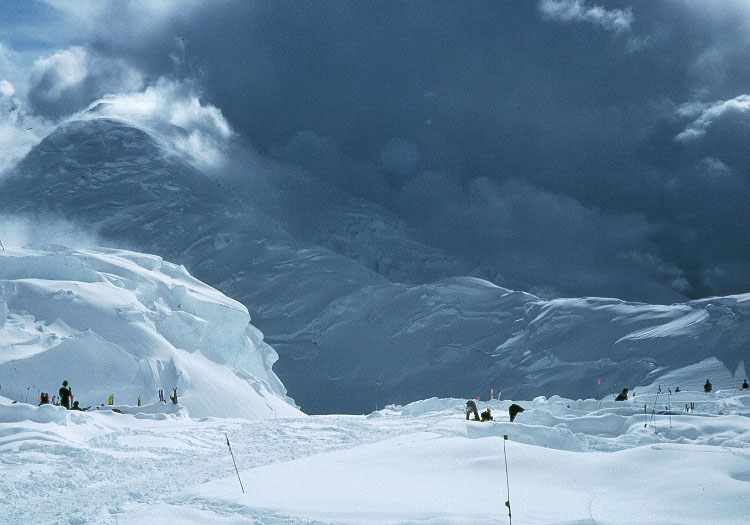
Storm approaching the 11000' camp
14 June We decide to have a rest day. I Wash underwear in a ziploc and dry them in the air. Watch a storm approach.
15 June Move camp to 14400 in heavy snowfall. We are very tired by the time we get our tents up.
16 June Sleep in, then retrieve our cache we left below on the 13th. Select gear to cache higher, including food and fuel for five days.
17 June Carry gear to just below the West Rib at a bergschrund and level campsite (16300 ft). Cache the gear near two AAI tents. Bob suffers from stomach cramps and Julian has a headache.
18 June We take another rest day. It is windy in camp and there are big snow plumes off the Rib.
19 June We take a second rest day, waiting for a better weather pattern. I have low spirits due to a forecast of three more days of winds and clouds up high.
20 June A Low pressure system lingers,
but the forecast is for it to break up in a day or two. Move camp up to
the bergschrund cache (16300 ft). Julian gets carbon monoxide poisioning
from the stove and altitude but eventually recovers in the evening.

Lyle fixing line on the Upper West Rib
21 June We sleep in, then carry to 17200 feet. Lyle sets up fixed lines for much of the route. It is fantastic weather: little or no wind, warm temperature, and clear sky above. The forecast claims two more days of the same!
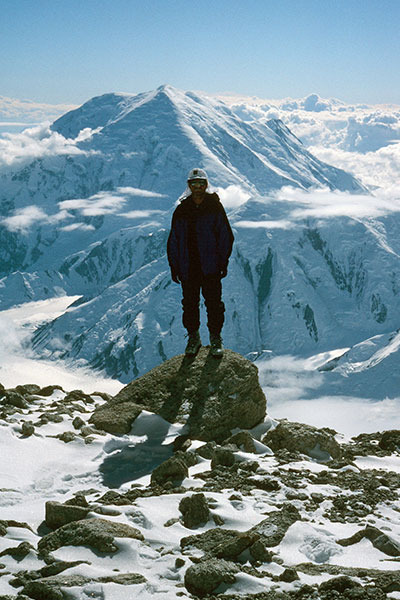
View from the 17200' campsite
22 June Move our camp up the fixed
lines to our highest campsite in beautiful weather. Anchor and protect
our tents as best we can. A storm is forecasted to arrive as early as
tomorrow night.
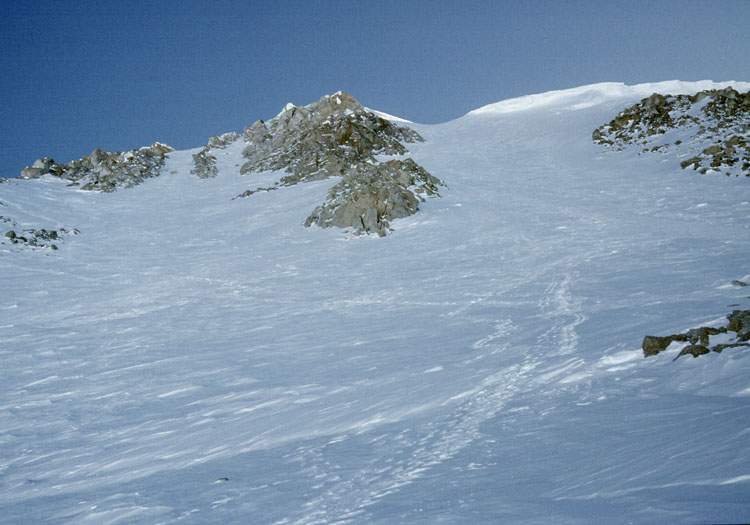
The Orient Express
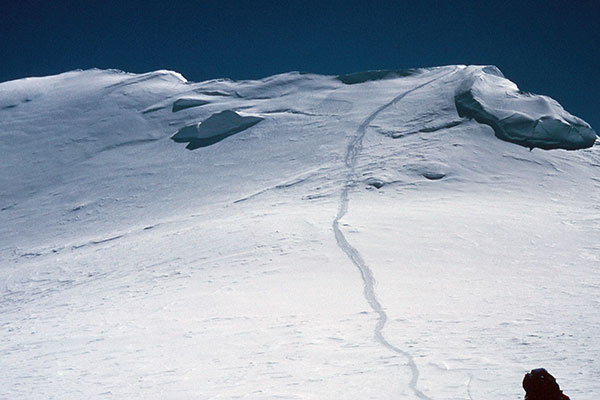
Heartbreak Hill

Denali's summit ridge
23 June We start brewing at 3am after
little sleep. Jim is feeling too poorly to climb. The rest of us leave
camp at 7:30am. I have cold feet climbing up the mixed rock and snow band
above camp, but they warm up on the Orient Express. We take a very short
break high on the Orient Express, then continue on. We move very slowly
up Heartbreak Hill, and I watch the sky nervously. My mind seems a bit foggy.
We eventually summit.
The air is calm and the temperature is about -10 F. My mind clears on the descent
of the Orient Express and I enjoy the rest of the descent to camp. We return to camp
about 7:30pm where Jim has melted snow to replentish our water. We see
a storm approaching, so decide to move down to 14400 feet. One of the
clients is weak and short of breath at the bergschrund camp, so we
camp there.
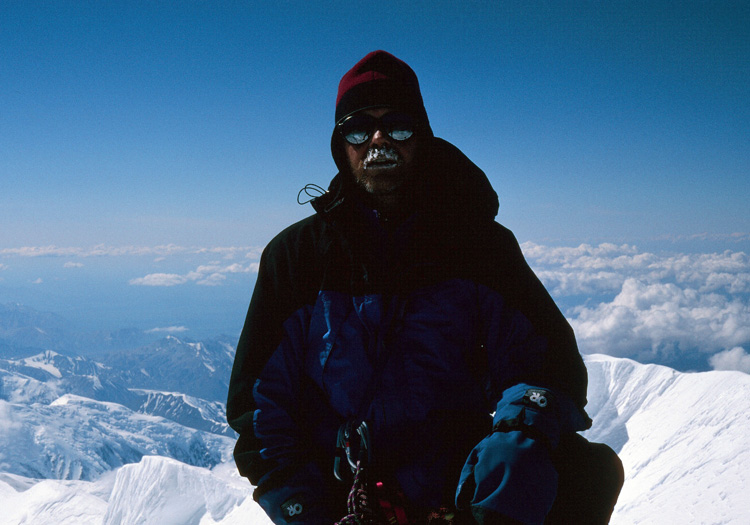
Paul on the Denali summit
24 June We rest and wait out the storm while the client recovers. A minor avalanche sluffs onto our tent. We are concerned about snow buildup on the Orient Express above our descent route to 14400, but by the end of the day we think it may have settled.

Looking down on the Kahiltna Glacier and Mt. Foraker from Denali
25 June We descend to the 14400 foot campsite and dig out and distribute the cache we left there on the 20th. We then descend past Windy Corner to our cache at 11000 feet below Motorcycle Hill. Windy Corner is not too bad, but we have blowing snow and low visibility as we descend the 700 feet to the top of Motorcycle Hill. We camp at the bottom of the hill because Lyle thinks conditions will be worse below and we are going too slowly to descend to better conditions at 8000 feet.
26 June We make good progress through Kahiltna Pass, but then get hung up in low visibility when we lose the wanded route below. We finally find the wanded route, but lose it again near the top of Ski Hill. We make camp and hope for better visibility tomorrow.
27 June The weather clears at and below our camp in the morning so we break camp and descend to the landing strip. Doug Geeting sends two planes while we stuff ourselves with beer and snacks at our cache there. The planes just take people -- the weather is threatening. One plane does return later to retrieve half of our gear.
28 June We wait all day in Talkeetna for our bags, which finally arrived about 9pm. I get a room at the Roadhouse since the Swiss Alaska is full. I explore shuttle opportunities for the Anchorage Airport tomorrow.
29 June Catch a 10:30am Talkeetna Shuttle Service and arrive at the airport at 1:30pm. It is early, but I do not want to risk missing the only shuttle today. Two of the other passengers are Steve Swenson and Alex Lowe [Alex later died in 1999 on Shishapangma in Tibet].
30 June I fly to Portland, Oregon, where Linda picks me up. She is startled at how much weight I have lost.
Links
Summitpost (Denali)Summitpost (Sultana)
Map
![]() = Peaks climbed
= Peaks climbed
![]() = Unclimbed peaks
= Unclimbed peaks
Pros and cons of using a guide service
I posted the following response to a query in the USENET forum rec.climbing:
Re: Climbing Denali! Date:1996/07/12 Forums:rec.climbing D. Morrison wrote: > I'm planning on climbing Denali next season, and I'm looking for > suggestions and comments on subjects including the pros and cons of > using a guide service, different routes, etc. I've done a fair amount > of climbing in the Pacific Northwest, including multiple ascents of many > of the major glaciated peaks, several of which I've led. I just returned from climbing Denali via the Upper West Rib. I joined a Fantasy Ridge Mountain Guide group lead by Lyle Dean and Jim Nigro. Our plan was to climb the entire West Rib. But we were tentbound three days due to heavy snowfall and poor visibility when we were trying to get up the NE Fork of the Kahiltna (the "Valley of Death"). Lyle eventually decided we had to start moving up one way or another and decided to take the West Buttress route to 14200'. This was a good decision, as a massive avalanche came down the NE Fork the next day. Lyle had the experience to know when to move and when to wait. We got into position and were able to summit from 17000' on the West Rib during a window of good weather. Lyle saw the forecasted poor weather coming and had the experience to know to drop down to 16200' our summit evening to avoid an "epic" at that high camp in poor weather. We waited an extra day at 16200' for the Orient Express to settle after the snowfall, then started down for the landing strip the next day. It took three days to get to the landing strip due to poor weather, including a whiteout at Kahiltna Pass where we lost the wanded route for two hours. We all got out safely and had a great experience on the mountain. During this same time Vern Tejas was leading a Fantasy Ridge group up the West Buttress. Vern's group had to wait several days at the 17000' camp on that route due to high winds up high. But they were ready and in position when the weather cooperated and the group was successful. The point of this story is that a major advantage of using a good guide service is the strong, experienced leadership you will hire. A related advantage is that you can attempt a more technical route than what you might otherwise feel qualified for. Finally, you will spend most of a month with a world-class climber and have the opportunity to learn from him/her. One disadvantage of using a guide service is that you will have to adjust to living a month in close quarters with people you don't know and who may have annoying habits. Be flexible and tolerant. Another risk is that one or more of the other clients may be unprepared for an ambitious route. Hopefully this will become apparent to them early in the trip and they will decide to bail before the group commits to the route. We had one client decide to go home after five days. Since Lyle had decide to take the Buttress route to 14200' we were able to get him back to the landing strip without incident and without sacrificing our climb. Finally, you will may feel the loss of some individual initiative, independence, and accomplishment if you use a guide service. I rationalized this for myself by choosing the West Rib route, rather than the West Buttress route. I'm glad I made that choice. A guide service provides some logistics that you would otherwise need to provide: food, tents, group climbing gear, etc. This may be an advantage or disadvantage, depending on their choices. We had fresh food lower on the mountain which seemed to be heavier and too slow to cook than it was worth. Higher on the mountain we had high-quality quick-cooking meals. It sounds like your Cascade climbing experience is comparable to mine. I had previously climbed Potocatepetl and Orizaba in Mexico with the American Alpine Institute and lead Cotopaxi in Ecuador with friends, so I did have some high altitude experience. If you decide to use a guide service I'd recommend you consider climbing the West Rib with Fantasy Ridge Mountain Guides.

